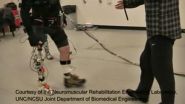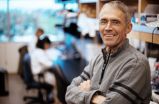(Press-News.org) Lugano/Geneva, Switzerland, 21 November 2014 - The possibilities for personalised vaccines in all types of cancer are revealed today in a lecture from Dr Harpreet Singh at the ESMO Symposium on Immuno-Oncology 2014 in Geneva, Switzerland.
"One of the biggest hurdles in cancer immunotherapy is the discovery of appropriate cancer targets that can be recognised by T-cells," said Singh, who is scientific coordinator of the EU-funded GAPVAC phase I trial which is testing personalised vaccines in glioblastoma, the most common and aggressive brain cancer. "In the GAPVAC trial we will treat glioblastoma patients with vaccines that are ideal for each patient because they contain personalised antigens."1
For all patients in the GAPVAC study, researchers will identify genes expressed in the tumour, peptides presented on the human leukocyte antigen (HLA) receptor (i.e. peptides which will be seen by T-cells), cancer specific mutations, and the ability of the immune system to mount a response to certain antigens. Based on this information, two vaccines, called actively personalised vaccines (APVACs), will be constructed and administered following conventional surgery.
The first vaccine will be prepared from a warehouse of 72 targets previously identified by the researchers as relevant for treatment in glioblastoma. These peptides have been manufactured and put on the shelf ready to be vaccinated in patients. Patients will be given a cocktail of the peptides they express and which their immune system can mount a response to.
Singh said: "A patient may express 20 of these 72 targets on their tumour, for example. If we find that the patient's immune system can mount responses to 5 of the 20 targets, we mix the 5 peptides and give them to the patient. We mix the peptides off the shelf but the cocktail is changed for each patient because it is matched to their biomarkers."
The second vaccine is synthesised de novo based on a mutated peptide expressed in the tumour of the patient. Singh said: "That peptide is not in our warehouse because it just occurs in this one single patient. The patient receives APVAC-1 and APVAC-2 in a highly personalised fashion in a way that I think has never been done for any patient."
He added: "GAPVAC has two major goals. One is to show that personalised vaccines are feasible, since this is one of the most complicated trials ever done in cancer immunotherapy. The second is to show that we can mount far better biological responses in these patients compared to vaccination with non-personalised antigens."
Singh's previous research has shown that vaccination with non-personalised antigens leads to better disease control and longer overall survival in phase I and phase II clinical studies in patients with renal cell cancer.2
Singh said: "For the non-personalised vaccines we used off-the-shelf peptide targets that were shared by many patients with a particular cancer. Using this approach we have successfully vaccinated patients with renal cell cancer, colorectal cancer and glioblastoma."
He added: "During this research we identified other targets that appeared in very few patients or even, in extreme cases, in a single patient. Often these rarer peptides are of better quality, meaning they are more specifically seen in cancer cells and occur at higher levels. This led us to start developing personalised cancer vaccines which contain the ideal set of targets for one particular patient. We hope they will be even more effective than the off-the-shelf vaccines."
Singh continued: "A very simple example from something established is trastuzumab in breast cancer. Trastuzumab was originally given to every breast cancer patient and the efficacy was just seen in a subset. Now only about 20% of breast cancer patients receive trastuzumab and the personalised aspect is just based on the low abundance of Her2, the target."
Singh believes that personalised vaccines hold promise for all types of cancer, and that personalisation could also be applied to adoptive cell therapy.
He concluded: "Personalisation is not limited to vaccines but is a general principle that could be applied to cancer immunotherapy more broadly. We are starting with vaccines but we are also thinking about how to use personalised antigens in adoptive cell therapy."
INFORMATION:
Notes and references
1 Glioma Actively Personalised Vaccine Consortium (GAPVAC): http://www.gapvac.eu
2 Walter S, et al. Multipeptide immune response to cancer vaccine IMA901 after single-dose cyclophosphamide associates with longer patient survival. Nat Med. 2012;18(8):1254-1261. doi: 10.1038/nm.2883. Epub 2012 Jul 29.
Session
"Novel cancer antigens for personalised immunotherapies" - Friday, November 21 - Session 3 - 13:10 CET.
Disclaimer
Information contained in this press release was provided by the abstracts authors and reflects the content of the studies. It does not necessarily express ESMO's point of view.
About the European Society for Medical Oncology
The European Society for Medical Oncology (ESMO) is the leading European professional organization committed to advancing the specialty of medical oncology and promoting a multidisciplinary approach to cancer treatment and care.
ESMO's mission is to advance cancer care and cure through fostering and disseminating good science that leads to better medicine and determines best practice.
ESMO's scientific journal, Annals of Oncology, ranks among the top clinical oncology journals worldwide. ESMO events are the meeting place in Europe for medical oncologists to update their knowledge, to network and to exchange ideas.
To find out more about ESMO, please visit: http://www.esmo.org
Public health researchers from the University of Adelaide have evaluated international breast cancer guidelines, finding that there is potential to improve surveillance of breast cancer survivors from both a patient and health system perspective.
International guidelines recommend annual follow-up mammograms for every woman after treatment for early breast cancer, regardless of the risk of her cancer returning. There is also no strong evidence to support annual mammography compared with other possible mammography schedules.
In a paper published in the journal Value ...
VIDEO:
Powered lower limb prosthetics hold promise for improving the mobility of amputees, but errors in the technology may also cause some users to stumble or fall. New research from the...
Click here for more information.
Powered lower limb prosthetics hold promise for improving the mobility of amputees, but errors in the technology may also cause some users to stumble or fall. New research examines exactly what happens when these technologies fail, with the goal of developing ...
Bethesda, MD (Nov. 21, 2014) -- Cirrhosis and nonalcoholic fatty liver disease (NAFLD) are two serious liver conditions with limited pharmacological treatments. The December issues of AGA's journals -- Clinical Gastroenterology and Hepatology and Gastroenterology -- highlight important updates into treatments for these two debilitating diseases.
For access to any of these studies, or to speak with the study authors, please contact media@gastro.org or call 301-272-1603.
Promising Probiotic for Liver Disease
A study published in Gastroenterology1 found that, over a ...
EAST LANSING, Mich. --- Don't get along with your boss? Your job performance may actually improve if the two of you can come to grips with the poor relationship.
A new study led by Michigan State University business scholars finds that workers are more motivated if they and their supervisors see eye-to-eye about a bad relationship than if they have different views about their relationship. The findings are published in the Academy of Management Journal.
"Seeing eye-to-eye about the employee-supervisor relationship is equally, if not more important than the actual quality ...
SCOTTSVILLE, SOUTH AFRICA-- Worldwide, drought conditions, extreme temperatures, and high soil saline content all have negative effects on tomato crops. These natural processes reduce soil nutrient content and lifespan, result in reduced plant growth and yield, and ultimately translate to lower profits for tomato producers. As an alternative to unsustainable practices such as the use of synthetic fertilizers, producers are looking to environment-friendly soil ameliorants such as verimcompost leachate, an organic liquid produced from earthworm-digested material and casts ...
TUSCON, AZ - Soil solarization, a process that uses solar radiation to rid the soil of pests, is most common in regions with high solar radiation and high temperatures during the summer season. An alternative to soil fumigation, the process is used either alone or in combination with fumigants. To accomplish solarization, solar radiation is used to passively heat moist soil covered with clear plastic sheeting, with the goal of increasing soil temperatures to the point where they are lethal to soilborne organisms. The effectiveness of solarization is based on the actual ...
Quebec City, November 21, 2014--Scientists from Université Laval, the University of British Columbia and the University of Oxford have discovered a natural resistance gene against spruce budworm in the white spruce. The breakthrough, reported in The Plant Journal, paves the way to identifying and selecting naturally resistant trees to replant forests devastated by the destructive pest.
A research team composed of professors Éric Bauce, Joerg Bohlmann and John Mackay as well as their students and postdocs discovered the gene in spruces that had remained relatively ...
Employees who work at small, locally owned businesses have the highest level of loyalty to their employers -- and for rural workers, size and ownership of their company figure even more into their commitment than job satisfaction does, according to Baylor University researchers.
Higher levels of commitment are associated with less absenteeism, lower turnover and less seeking of jobs outside the company. The study -- "Small, local and loyal: How firm attributes affect workers' organizational commitment" -- is published in the journal Local Economy.
"It's an interesting ...
LA JOLLA, CA - November 20, 2014 - Scientists at The Scripps Research Institute (TSRI) have discovered how one gene is essential to hearing, uncovering a cause of deafness and suggesting new avenues for therapies.
The new study, published November 20 in the journal Neuron, shows how mutations in a gene called Tmie can cause deafness from birth. Underlining the critical nature of their findings, researchers were able to reintroduce the gene in mice and restore the process underpinning hearing.
"This raises hopes that we could, in principle, use gene-therapy approaches ...
There are plenty of body parts that don't grow back when you lose them. Nails are an exception, and a new study published in the Proceedings of the National Academy of Sciences (PNAS) reveals some of the reasons why.
A team of USC Stem Cell researchers led by principal investigator Krzysztof Kobielak and co-first authors Yvonne Leung and Eve Kandyba has identified a new population of nail stem cells, which have the ability to either self-renew or undergo specialization or differentiation into multiple tissues.
To find these elusive stem cells, the team used a sophisticated ...




